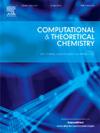有机太阳能电池高光电性能非熔接环电子受体的端封改性及计算评价
IF 3
3区 化学
Q3 CHEMISTRY, PHYSICAL
引用次数: 0
摘要
非熔合环电子受体(NFREAs)因其合成简单、生产成本低而成为有机太阳能电池中很有前途的一类非富勒烯受体。然而,它们经常面临着低分子平面度、高电荷重组和低效电荷转移等挑战。在本研究中,利用密度泛函理论,通过末端修饰设计了8个新的NFREAs (CP1-CP8),并对其光伏性能进行了评价。其中,CP2的HOMO-LUMO间隙(1.693 eV)、激发能(1.338 eV)和结合能(0.274 eV)均低于参比分子。CP7在所有参数中表现出平衡的性能,而CP4达到了最高的开路电压1.767 eV和最高的功率转换效率33.31%。其他的分析证实了由于端帽的修改,光电子性能得到了改善。因此,这些新设计的分子具有增强的稳定性和光伏性能,在有机太阳能电池中表现出巨大的潜力。本文章由计算机程序翻译,如有差异,请以英文原文为准。

End-capped modification and computational evaluation of non-fused ring electron acceptors with high photovoltaic performance for organic solar cells
Non-fused ring electron acceptors (NFREAs) are a promising category of non-fullerene acceptors for organic solar cells due to their simpler synthesis and lower production costs. However, they often face challenges like low molecular planarity, high charge recombination, and inefficient charge transfer. In this study, eight new NFREAs (CP1-CP8) were designed through end-capped modifications based on a reference molecule using density functional theory to evaluate their photovoltaic properties. Among them, CP2 exhibited the lowest HOMO-LUMO gap (1.693 eV), excitation energy (1.338 eV), and binding energy (0.274 eV), compared to the reference molecule. CP7 demonstrated a balanced performance across all parameters, while CP4 achieved the highest open-circuit voltage of 1.767 eV and the highest power conversion efficiency of 33.31 %. Other analyses confirmed improvements in photoelectronic properties due to the end-capped modifications. Therefore, these newly designed molecules, with enhanced stability and photovoltaic performance, exhibit significant potential for organic solar cells.
求助全文
通过发布文献求助,成功后即可免费获取论文全文。
去求助
来源期刊

Computational and Theoretical Chemistry
CHEMISTRY, PHYSICAL-
CiteScore
4.20
自引率
10.70%
发文量
331
审稿时长
31 days
期刊介绍:
Computational and Theoretical Chemistry publishes high quality, original reports of significance in computational and theoretical chemistry including those that deal with problems of structure, properties, energetics, weak interactions, reaction mechanisms, catalysis, and reaction rates involving atoms, molecules, clusters, surfaces, and bulk matter.
 求助内容:
求助内容: 应助结果提醒方式:
应助结果提醒方式:


